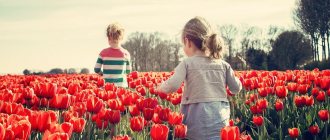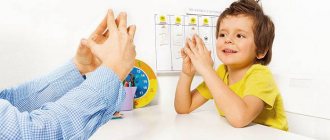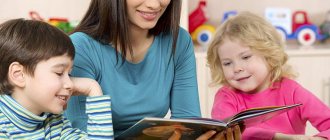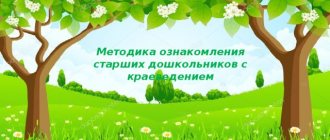The importance of environmental education for preschool children
Svetlana Evseeva
The importance of environmental education for preschool children
THE IMPORTANCE OF ECOLOGICAL EDUCATION FOR PRESCHOOL CHILDREN.
The formation of the initial foundations of ecological culture is the accumulation of specific, sensory ideas about objects and natural phenomena that surround children and are part of their life activities. An important aspect of environmental education is the formation of children’s understanding of the specifics of a living object, its fundamental difference from an object (inanimate object), the formation of elementary skills of proper interaction with plants and animals, participation in activities to create the necessary conditions. Raising children will not become ecological if already at this age they will not understand: the plant on the window needs water, the parrot in the cage needs grains and water, the birch tree and flowers on the site need water, and the birds in winter need feeders and bread crumbs. Familiarization with natural objects, their parts, basic properties, visual ways of functioning in under completely certain conditions - this is the formation of initial ecological ideas ... The correct attitude towards living things is the end result, an indicator of environmental education , manifested at this age only in the voluntary and active participation of children in joint activities with adults.
Environmental education of preschool children involves the development of a humane attitude towards nature (moral education , the formation of a system of environmental knowledge and ideas (intellectual development, the development of aesthetic feelings (the ability to see and feel the beauty of nature, the participation of children in activities feasible for them to care for plants, to protect and protection of nature.
When forming a humane attitude towards nature, it is necessary to proceed from the following: the main thing is that the child understands that man and nature are interconnected. Feelings of compassion and empathy determine an effective attitude towards nature, expressed in a willingness to take care of those who need it. It must be remembered that children’s often careless and sometimes cruel attitude towards nature is explained by their lack of the necessary knowledge. That is why the education of empathy and compassion occurs in inextricable unity with the formation of a system of environmental knowledge accessible to preschoolers , which includes:
Ideas about plants and animals, their needs and ways to satisfy these needs; understanding the relationship between living beings and their environment, realizing that all living beings on Earth are connected to each other by a complex system of relationships (biological balance)
and at the same time, each of them has its own
ecological niche , and all of them can exist simultaneously.
Together with parents and children, we created an environmental book (based on the poem I gave about wildlife, attitude towards animals, rules of behavior in nature, they drew a picture) I bring to your attention the cover of the book!
Forms and methods of working with children
Nature conservation is a process in which every person is involved. Therefore, from the very beginning it is worth paying attention not only to traditional lectures and conversations, but also to interactive activities. The more the children are involved in the work, the more interesting they are in the classes, the greater the conclusion they will draw from the results of the lessons.
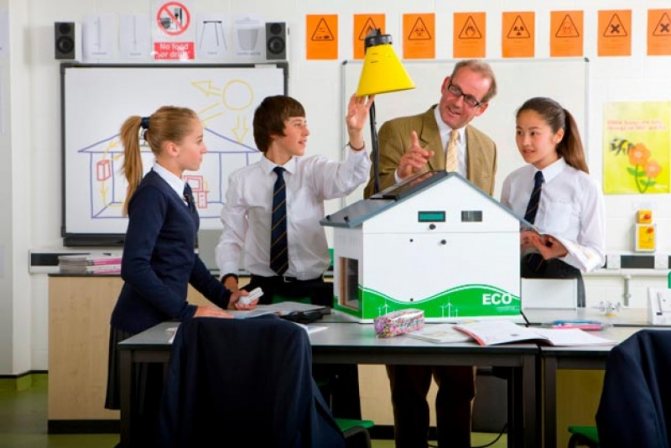
Teacher and students with a model of an ecological house study alternative energy
You can work with children in lessons dedicated to environmental education using several methods:
- Verbal. Such methods are good because they are used when working with children of any age.
In kindergarten, conversations or stories can be held in simple language and using a large amount of illustrative material.
Schoolchildren already understand simple terms and operate with more complex concepts.
- Visual. Although such methods are considered suitable for children 2-10 years old, they are also used in high school. Only the approach to the selection of illustrations changes: they become more complex and begin to show diagrams, graphs and other abstract diagrams.
In this case, attention should be paid to showing educational films that all children enjoy.
- Practical. Here preschoolers and schoolchildren will have to work independently.
They can sort household waste, take care of shared pets in the “Living Corner” or clean up the area near the school during cleanup days.
Separately, it is worth mentioning the project method, which is now actively used in Russian schools. Primary school students are usually asked to simply select theoretical material on the topic of rational use of natural resources and present it beautifully. Teenagers can formulate their own opinions and ideas about how to protect the environment.
Preschool age
Environmental education was introduced into the Federal State Educational Standard for preschool institutions relatively recently. Although earlier, during classes on getting to know the outside world, conversations on this topic were still held with the kids. The new standard involves a more in-depth study of the problem and allows the use of interactive forms of work:
- Teacher's lectures. During such a lesson, the teacher discusses a certain topic with the children (“Why you shouldn’t destroy birds’ nests”). At the same time, visual aids are used: illustrations, excerpts from literary works.
The purpose of such activities is to provide the child with more information about nature and explain why destroying it is bad.
- Practical lessons. They can be a continuation of the lecture or have their own separate topic. During practice, kids are taught useful skills (how to sort garbage) or are asked to do something important for the inhabitants of nature. Many schoolchildren make a birdhouse and prepare food for birds.
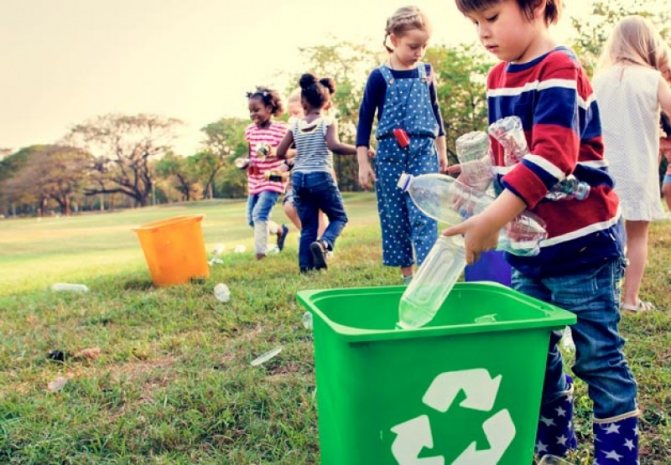
- Exercises using a projector . The use of multimedia technologies helps to show children presentations, themed films or cartoons. It is important that preschoolers perceive information better visually, so for them the presence of illustrations and explanatory pictures makes it easier for them to assimilate information.
- Creative works . They are given to groups both during competitions (for the best environmental poster) and as part of a thematic plan. Such tasks help to show the child’s creative potential and will allow him to express his own attitude to environmental problems.
In the warmer months, children are taken on themed walks. Such “hikes” are designed to introduce children to the diversity of natural phenomena and give them more information about the world around them. Teachers tell their students about species that are on the verge of extinction and explain that nature must be protected.
Practical classes are especially important for urban children, who are quite isolated from the outside world and spend most of their time on the streets of megacities.
School age
Environmental education is not taught in schools as a separate subject. It is up to the class teacher or teachers of such disciplines as “The World Around us,” “Biology,” or “Social Studies” to develop a child’s caring attitude towards the world around him. Some schools have ecology clubs, where problems of human influence on the planet are taken more seriously.
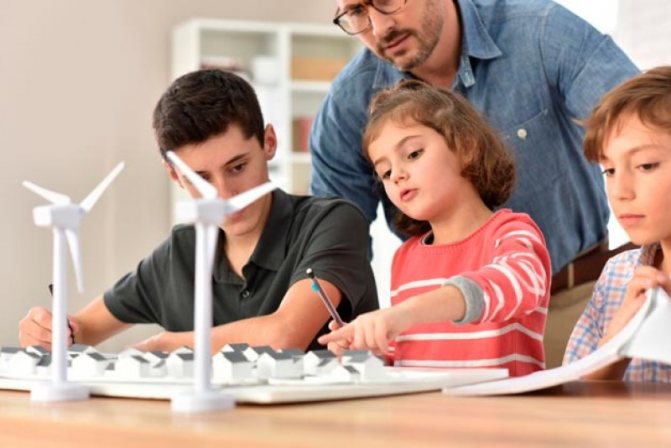
Among the forms of work with children 7-16 years old are:
- Group work in class . Organized after listening to a teacher’s story on a specific topic. Children can answer questions about the content of the material, draw up tables and graphs, and complete other tasks given by the teacher.
- Independent research . This usually involves writing reports on environmental topics. At an older age, schoolchildren may be asked to prepare a presentation about environmental problems, which will be demonstrated in front of the whole class.
- Themed games . Such classes allow children to become interested in current issues of our time and test their level of knowledge on the subject.
- Practical lessons . This work option has many variations. The class can go on a themed excursion or go on a hike. Teenagers are often involved in volunteer activities. Students enjoy a variety of experiments that show in practice how man destroys and pollutes nature.
- Project activities . High school students who have accumulated enough knowledge about the negative impact of humans on the planet are often asked to make projects on their own. Such work should contain a specific proposal: how to make a city or region cleaner, avoid river pollution and teach others to take care of nature.
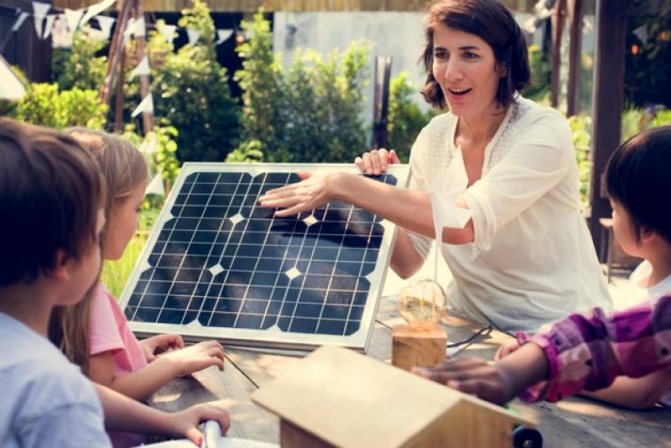
Children are taught about solar panels
Recently, Russia began to hold ecology Olympiads among schoolchildren. The most talented children take part in them and develop their own projects to protect the environment.
THE BEST TOOL OF EDUCATION IS GAME
This is true. Gaming activities develop, educate, teach. At the same time, it is fun, interesting, without coercion. So the development of a child through didactic games is one of the most effective means of teaching environmental (and any other) literacy.
The game can be played both during walks and outside.
In the first case, a preschooler can study the appearance and properties of earth, water, clay, sand, ice, and snow. For example, you can offer your child:
- play snowballs;
- To make a snowman;
- hold the ice in your hands, breathe on it;
- make a sun or a tower out of ice floes;
- make Easter cakes from sand;
- compare clay and earth by touch;
- make bricks from clay;
- pass water mixed with clay through a layer of sand;
- compare how sand and clay behave in water, etc.
In the second case, you can arrange a family game at home, inviting friends to visit. These could be, for example, games in the form of lotto:
- What grows where?
- Who lives where?
- Who eats what?
In this case, you need to choose among the lotto cards those that correspond to the environment depicted on each card.
Games in the form of quizzes:
- find by description (you need to find a picture that matches the description of a bird, animal, season);
- recognize and name (recognize an animal or bird by sounds, tracks);
- when does this happen (determine the time of year, natural phenomenon from the description).
There are many educational games on ecology. You can throw a ball to a child, naming a general class (for example, pets), and in response the child, having caught the ball, must give an example. You can arrange a competition to see who can best draw what is described on the card in text format. Or divide the children into 2 groups and ask them to unite in such a way that the upper parts of the plants in the pictures of some coincide with the lower parts of the pictures of others (tops and roots). You can ask kids to imitate the movements of the birds or animals shown in the picture. Or ask them to remove an extra link in some chain of images...
READING IS THE BEST STUDY
Preschool age is the time when reading books evokes the most vivid emotional response in a child, makes you empathize and think about what you read. The conclusions drawn after reading the book remain in the child’s memory for a long time.
Literature on environmental education is, first of all, the works of V. Bianchi. In the form of entertaining stories or fairy tales, they help the child understand complex natural phenomena, the patterns of the natural world, talk about the interaction of the organism with the environment, and the forms of its adaptation to its habitat.
You can also tell a preschooler about the beauty and diversity of native nature using the examples of the works of M. Prishvin, F. Tyutchev, A. Pushkin, A. Fet, K. Ushinsky, N. Nekrasov, L. Tolstoy, N. Sladkov and others.
Reading children's encyclopedias devoted to natural areas, climate, animals, and plants will also be useful in terms of improving environmental education. Bright pictures in them contribute to more effective memorization of accurate information. But fairy tales, proverbs and sayings, which can also be classified as “ecological”, carry figurative information, which is also useful.
Raising a child begins in the family. The harmonious development of children in the future depends on how correct it is. In environmental terms, too.
